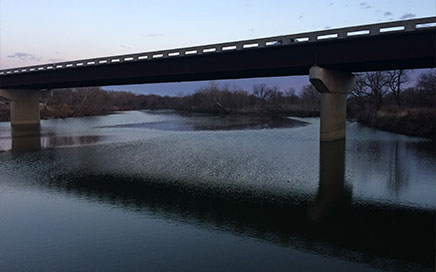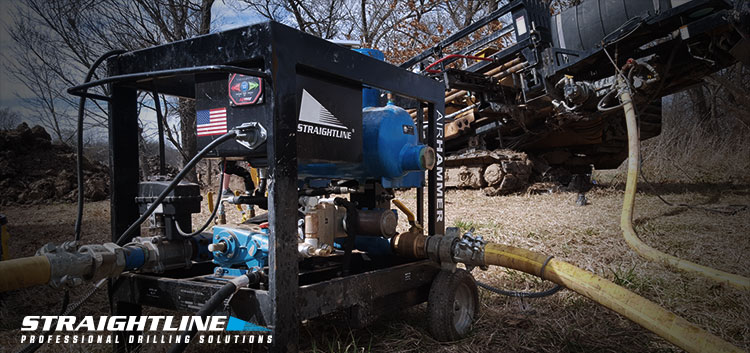
Location: Baxter Springs, Kansas
Equipment: StraightLine HDD® RockEye 5.0 Hammer System on a Vermeer 36×50 paired with an Atlas Copco XRVS 1550 compressor.
The Challenge:
Oklahoma-based HDDI, Inc., received a contract to complete a 750-foot, 1.5- and 2-inch fiber conduit installation in extreme Southeast Kansas. The area, located along the historic Route 66, is noted for its tough limestone conditions. In fact, the Spring River location where the HDDI crew set up boasted a 100 percent horizontal directional drilling failure rate.
Estimated at 30,000 PSI, the HDDI crew learned this particular limestone, part of the Ozark Plateau formation, contained a substantial amount of chert (i.e. flint). The result was a rock whose hardness was matched by an equally high degree of abrasiveness.
Part of the Ozark Plateau limestone formation, the Spring River location where the HDDI crew set up boasted a 100 percent horizontal directional drilling failure rate.
Entry and exit points on both sides consisted of an 8-10 foot layer of river sediment. The limestone layer, described by the crew as almost “shelf-like,” made entry angle critical. Additionally, the crew also learned the exit side contained limestone boulders resting above the layered limestone bedrock. Unknown to the crew at the time, these boulders would later become a significant factor.
Read more about this bore’s tough geology here.
Mud Motor Strategy Comes Up Short
Arriving on the job site, 26-year drilling veteran Jerrod Wood felt an abundance of horsepower would overcome the limestone conditions. Underpinning the strategy was the company’s Vermeer 80×100, paired with a mud motor. Setting up approximately 150 feet from the river’s edge, Wood wanted to give his crew plenty of room to achieve proper depth and flat trajectory (ideally in the +/- 2 degree range) by the time the mud motor head arrived at the river bank.
Running the 80×100, mud motor and PDC combo, the crew struggled from the outset. Production rates were an excruciating slow 3-4 hours per 15-foot rod. The chert/limestone also proved destructive to tooling. As days turned into weeks, the bore chewed up more than ten thousand dollars in tooling, including two PDC bits. Adding to the growing list of issues, the bore path was 15 feet deeper than desired and was at a -8 degree angle at the river’s edge. Wood, recalling the difficulties, said simply, “We pretty much tried every rock head there is and we didn’t have any luck with any of them.”
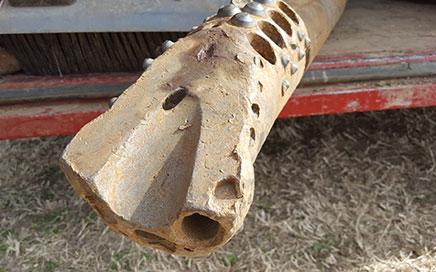
The HDDI team tried a variety of traditional rock tools, all with similar results. Wood later recalled: “We pretty much tried every rock head there is and we didn’t have any luck with any of them.”
Re-Thinking Tooling Choice
In re-thinking the situation, Wood recalled the success the company had drilling tough Nashville rock the previous spring using a 4.0 RockEye. Wood made the call: the company brought in their Vermeer 36×50 to run the RockEye 4.0.
Following up an impressive list of victories in the Nashville limestone, Woods’ confidence in the RockEye 4.0 was high. However, given the difficulty of the bore and the time already invested, Wood placed a call to arrange for StraightLine’s field engineer, Ron Becker, to consult on the job.
After arriving at the bore site, Becker assisted the HDDI crew in setting up the RockEye 4.0 hammer. As in previous attempts, the launch point was set approximately 150 feet from the river’s edge—however, this time, the rig would launch from the river’s east bank. An Atlas-Copco compressor powered the RockEye.
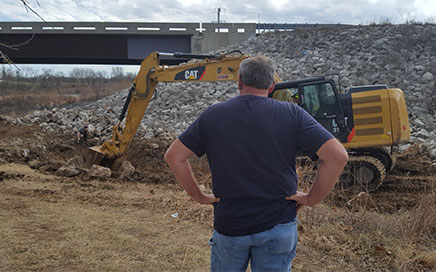
With weeks time already invested in the tough bore, the HDDI crew wanted StraightLine field-engineer, Ron Becker, to come to the job site to provide guidance and counsel.
The original bore plan remained the same, including making sure the hammer’s bit achieved the right depth, and level trajectory by the time it hit the river’s edge. The hammer entered the ground at 7:30 a.m. at a negative 18 degrees. Engaging the rock shelf easily, by the time the hammer hit the river’s edge, it achieved a 10-foot depth under the river bed, with a -2 degree slope—perfectly positioned to attack the limestone.
Over the next 570 feet, the hammer traversed the varying rock layers, recording production rates ranging from 1 to 3-minutes/per foot. By 5:30 p.m., the RockEye had cleared the western bank of the river. Fluid use for the entire bore was less than 300 gallons—representing a huge cost savings over the mud motor. The speed of production put the crew days ahead of schedule. However, due to time restrictions in place on the job site, the crew shut down operation for the day.
Spring River Has One More Trick Up Her Sleeve
Energized from the previous day’s success, the crew arrived early the next morning to execute a rapid rise in elevation to the exit pit. However, Spring River had one more trick up her sleeve. Attempting to steer up, Wood felt the head began to bind. Several attempts at swabbing the hole netted no improvement.
Fearing breaking off in the hole, the decision was made to excavate to gain access to the hammer. As excavation progressed, the cause of the binding became obvious: just above the solid limestone seam—resting in a soft mixture of sand/silt—were extremely large boulders. The crew reasoned the unsupported boulders were pressing on the bent sub, which prevented rotating the hammer.
Still working days ahead of schedule, the HDDI crew calculated that spending a day excavating was much better than risking the loss of the hammer. As excavation progressed, the size of the boulders encountered surprised the crew. As excavation operations spilled into a second day, the crew realized excavation was not working as planned.
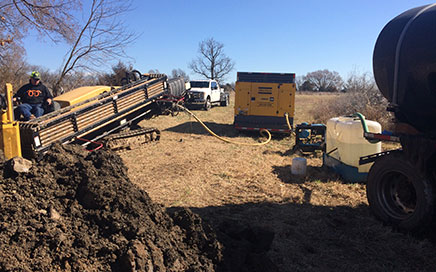
Jerrod Wood at the controls of the Vermeer 36×50 and RockEye Hammer System.
For a second time, Woods’ HDDI team found themselves contemplating a change in tactics.
Extending the Bore Takes Boulders out of Play
What the HDDI Team and StraightLine settled on was deceptively simple: Rather than trying to steer up through the boulders, the new plan called for stretching the length of the bore out another 250 feet. This strategy, would allow the hammer to engage the solid rock formation below the boulders, where the RockEye had already proven successful.
The strategy worked. Once engaged in the limestone, the HDDI hammer drilled the additional 250 feet to the existing bore on the fiber line within four hours. Despite the bore’s added length, the HDDI crew was pleased with the outcome on multiple levels.
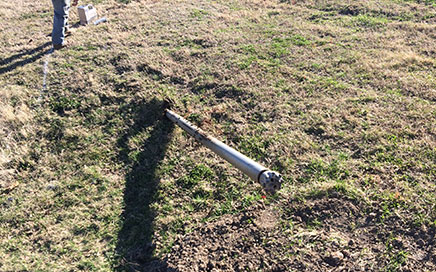
FINISH! After spending weeks toiling unsuccessfully with traditional tooling, the RockEye completed the bore in under 14 hours.
First, despite adding 250 feet to the bore, the crew was able to finish the pilot in less than 14 hours. “Considering we were here for weeks, mud motoring without punching out,” Wood says, “the hammer shortened the project by weeks.” Second, using under 300 gallons, represented an enormous reduction in mud procurement and handling costs. Finally, the hammer displayed very little wear, compared to the rock tooling destroyed during previous mud motor attempts.
Jerrod Wood summarized the successful pilot bore: ‘We’ve been up here running a mud motor for about three and one-half weeks. We went through three rock bits and had nothing to show for it. With the RockEye, we drilled the length of the river in one day—without having the cost of running a mud motor or re-claimer. Even with the time lost spent excavating, we still came out way ahead.”
